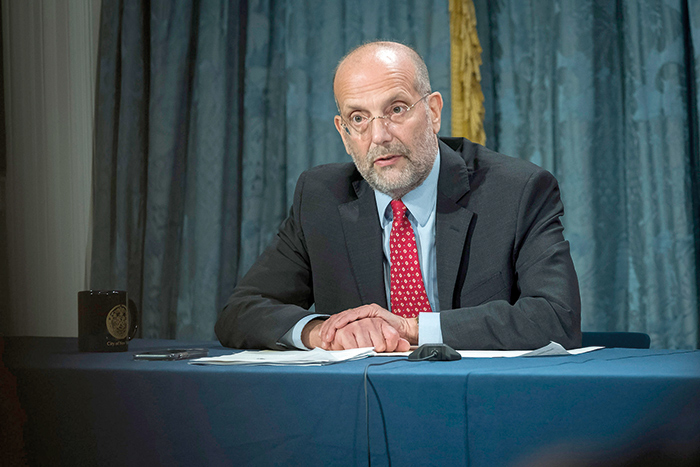Photo Courtesy of Ed Reed/Mayoral Photography Office
“We have taken aggressive action and pioneered strategic initiatives to ensure vulnerable New Yorkers have access to vital resources, including food assistance, which is more important than ever before in these unprecedented times,” DHS Commissioner Banks said.
By Forum Staff
Hunger Free America’s annual survey of hunger in New York City and state found that, in 2020, a historic surge in federal funding for Supplemental Nutrition Assistance Program benefits dwarfed the sharp hike in food distributed by charitable food pantries and soup kitchens.
The city’s food pantries and soup kitchens fed more than 65 percent more people in 2020 than in 2019. This is a huge jump compared to previous annual increases of ten percent in 2019, five percent in 2018, six percent in 2017, nine percent in 2016, and five percent in 2015.
“While charitable food pantries and soup kitchens citywide and statewide struggled heroically to meet the increased demand during the pandemic, they were only able to scratch the surface of the need, and the only thing that truly prevented mass starvation here was a historic surge in federal funding for SNAP benefits,” said Joel Berg, Hunger Free America’s CEO, at a virtual press conference last Wednesday afternoon to announce the findings of the report. “The City and State agencies that administer SNAP – and their rank-and-file employees – are our greatest hunger heroes in this crisis.”
At the same time, New York City’s SNAP caseload rose from 1,483,230 in March 2020 to 1,705,337 in September 2020 – an increase of 15 percent. The increase in caseload from March 2020 to April 2020 – an increase of 68,714 people – was the largest one-month increase in NYC’s history since 1980. Due to both the increased caseload as well as the state providing SNAP households with the maximum benefit allotment, the SNAP benefits received by City residents rose from nearly $218 million in March to $298.7 million in August – a 37 percent jump. If the current SNAP caseload and spending remains flat from September 2020, the SNAP program will provide $3.6 billion in federally-funded food dollars to low-income New York City residents over the next 12 months.
“We have taken aggressive action and pioneered strategic initiatives to ensure vulnerable New Yorkers have access to vital resources, including food assistance, which is more important than ever before in these unprecedented times,” said Department of Social Services Commissioner Steven Banks, who joined Hunger Free America at Wednesday’s virtual press event. “Since the outset of this pandemic, DSS-HRA has aggressively built on this foundation by implementing reforms at a scale and speed never before seen, using every tool at our disposal, to ensure we continue effectively providing this critical lifeline to the New Yorkers who rely on us to make ends meet. Hunger Free America’s report affirms the success of our extraordinary response and overall efforts in combating the hunger crisis. We are proud of our exceptional DSS-HRA staff and provider partners for their dedication during these challenging times, honoring our commitment to serving all New Yorkers in need no matter what.”
Hunger Free America’s survey also found that in 2020, nearly 33 percent of city food pantries and soup kitchens were forced to turn people away, reduce their portion sizes, and/or limit their hours of operation due to a lack of resources.

